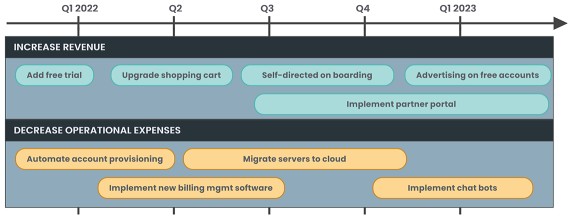You wouldn’t start off on an uncharted journey without a map, and accordingly, you wouldn’t—or shouldn’t—begin the process to create and launch a new product without a plan or roadmap in place, either.
Different audience perspectives require product managers to carefully consider what elements should be included in their roadmaps. For example, team members tasked with executing various elements might need more detailed timeframes and dates, while other stakeholders might only want to view key milestones.
In this blog post, we’ll explore how you can leverage certain MindManager® product roadmap templates to create roadmaps that are perfectly tailored to certain groups or stakeholder audiences.
Customizing product roadmaps by audience
With MindManager, you can customize various types or styles of project roadmaps to include filters and slides that enable viewers to drill down into various levels of detail, legends that outline the various components of the roadmap, and any other contextual or supporting details that help your audience(s) to fully grasp the product roadmap without needing a walkthrough or more in-depth explanation.
Product roadmaps for executives and other high-level stakeholders
Broad product roadmaps are created with high level stakeholders in mind, such as executives, analysts, investors, and even the media. They often encapsulate the initiatives you aim to achieve and how they fit into the company’s overall goals, the high-level timelines, the costs and staffing needs, and the financial and market size of the product opportunity.
Examples include:
- Executive roadmaps. Use these roadmaps to emphasize how your product will support the strategy and goals of the organization. They can span months or even several years to show your long-term vision and how products and versions may evolve over time.
- Focus-driven roadmaps. These offer a high-level view of your goal for developing a product and what outcomes you expect to achieve by doing so. They show how your product fits into the broader market, what problems it will solve, how current customers and prospects might be impacted, and what the overall revenue potential for the product is.
- Market roadmaps and technology roadmaps. These are useful for showing how a product fits into the broader ecosystem and the potential value it brings. These types of roadmaps also illustrate how your product aligns and/or integrates with emerging technologies, new releases, or updates, and internal and external technologies, which are both forms of focus-driven roadmaps.
- Orientation-driven roadmaps. These are roadmaps designed to serve different purposes, such as showing progress on current initiatives, themes, or desired customer and company outcomes.
Product roadmaps for product development teams
While broad product roadmaps are invaluable for presenting the bigger picture to executives and other high-level stakeholders, drilling down into the specifics is necessary when collaborating and communicating with team members who will do the work it takes to bring your product to life.
There are a variety of templates that you can use to create more focused product roadmaps. Depending on what fits your needs and goals, using one or a combination of these roadmaps can showcase your product management acumen and streamline the entire product development process.
Examples include:
- Internal development roadmaps. These roadmaps are typically designed with the actual product development team in mind. While the format may vary based on your team’s style (e.g., Agile, Kanban, Waterfall, or Scrum planning styles), some key elements of internal development roadmaps include the customer value(s) to be delivered, internal timeframes or release date targets, and other important milestones.
- Time-oriented roadmaps. These provide timeframes for key milestones and deliverables and enable the product team to visualize how and when the work will be performed. They can be ultra-specific with exact dates, or broader with quarterly plans or “now, next, later” timing.
- Product feature or product release roadmaps. These indicate when new products will be released and new or improved features will be launched, helping to coordinate release activities across important cross-functional teams such as marketing, sales, and customer support.
When determining what product roadmap template or templates will best present your strategy and plan to each group of stakeholders, keep in mind that each group needs to receive the information they require without being overwhelmed with unnecessary details.
Discover how to create your own visual product roadmaps and more with MindManager with our e-book and learn how MindManager can help you create product roadmaps for any need.
Learn more about the best practices for creating visual product roadmaps in the next article in this series.


